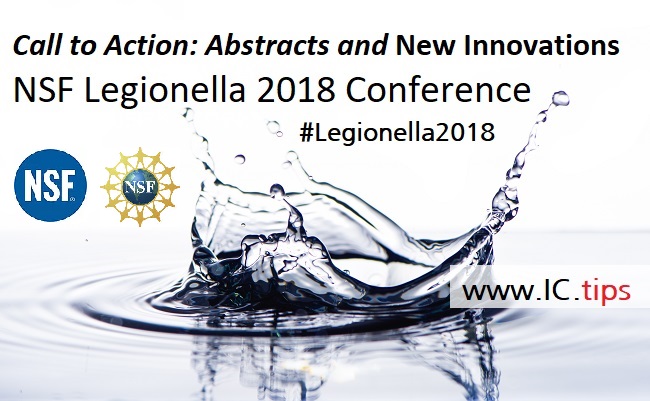Abstract
We tend to think of the developing world when addressing issues of safe water, but even in the developed world, there is significant risk posed by bacterial pathogens. Legionella bacteria and other regrowth microorganisms can be virtually eliminated at the water treatment plant, but they tend to colonize plumbing system biofilms, and people can be exposed to these pathogens by inhaling aerosols from showers and cooling towers. At the NSF Legionella 2018 conference, experts from around the world will come together to discuss practical management and prevention of Legionella and to discuss technical solutions to mitigate future outbreaks.
Main Article
Over 23,000 cases of legionellosis were reported in the United States from 1990 to 2005 (Nell and Berkelman, 2008). Legionellosis is a blanket term for two syndromes: Legionnaires’ disease and Pontiac fever. Pontiac fever presents with flu-like symptoms and is treatable whereas Legionnaires’ disease presents as a serious and potentially fatal pneumonia (CDC, 2011). Legionnaires’ is one of the causes of bacterial pneumonia, and has presented with a mortality rate between 5% and 30% (Benin et al, 2002).
Legionellosis is mostly caused by Legionella pneuomophila (Parr et al, 2015), an aerobic, Gram-negative bacterium that thrives in wet and warm conditions. It is found in bodies of water and soil, but the source of its real danger is in plumbing and cooling towers (Parr et al, 2015). Legionella are difficult to eliminate from plumbing systems after biofilms have been colonized. Exposures can occur from inhalation of aerosols from cooling towers, fountains, showers, and misters used for produce in grocery stores (CDC 2009).
“Almost all Legionnaires’ disease outbreaks are preventable with improvements in water system management.”
– Thomas Frieden, former director of CDC
According to CDC, Legionellosis accounts for 2/3 of reported US waterborne disease outbreaks in recent years (Benedict et al, 2017). The outbreaks of Legionella can be devastating, as they can have high morbidity rates, with legionellosis more predominant in males older than 50 years. At risk individuals tend to be older, smokers, and people with some immune deficiency, and health care facilities tend to be higher risk environments. However, the original Legionella outbreak occurrence in 1976 was in a hotel population. There are many technologies that have been offered to mitigate and prevent Legionella outbreaks, but each has particular characteristics that can affect their efficacy. Current water system treatments may not sufficiently eliminate all legionella microorganisms, and subsequent contamination and regrowth can occur after the water leaves the treatment plant. Guidance and some regulations may provide greater protection. Incorporation of heat shock treatments, chlorine, chloramines, silver/copper ionization, as well as UV or ozone in recirculating systems, are just some of the technologies that may mitigate these outbreaks (Cotruvo, 2014; Levin, 2014, Barker et al, 2015).
NSF Legionella 2018
On May 9-11, 2018, the NSF International Legionella Management conference will be held at the Baltimore Hilton. This conference brings together some of the most experienced public health thinkers and practitioners to review practical strategies that can be implemented today to identify, prevent, and mitigate risks from building water systems. The speakers and panels will discuss innovations in testing, water treatment, system modeling, plumbing design, and mitigation strategies to prevent the next illness or outbreak.
The conference will focus on practical management and prevention, and features US and international experts on all aspects of identifying risks, analytical and monitoring methodologies, and managing practical preventive and mitigation solutions. Attendees will learn the latest monitoring, mitigation, treatment technology and management approaches, and provide essential information for buildings, hospitals and other at-risk facilities, as well as mitigation providers, plumbing industry professionals, water suppliers, and public health authorities.
Call for New Innovations
Attendees are encouraged to present their new innovations, research and data at the conference in posters and floor comments to the audience of key opinion leaders. The deadline for abstract submissions is March 27 at 11:59 PM EST, 2018.
Please submit all abstracts to [email protected].
Please ensure that Poster abstracts adhere to the following guidelines:
- Poster Abstracts must be within the realm of Legionella and drinking water safety.
- Abstracts should be 400 words or less, and structured to include a purpose/hypothesis, methods, results, and significance section, as a general guidance.
- Include a title page that indicates the abstract title, all authors, their affiliations and degrees. Please include the contact information for one corresponding author. This is not included in the word count. Please disclose all potential commercial conflicts of interest for each author.
- Abstracts and their content cannot be previously published.
- Changes to abstracts will not be accepted after March 27 at 11:59 PM EST, 2018.
More information is available at the conference website: https://www.legionella2018.org/
Twitter: https://twitter.com/LegionellaConf/
LinkedIn: https://www.linkedin.com/company/11404533/
References
Barker, K. A., Whitney, E. A., Blake, S., & Berkelman, R. L. (2015). A review of guidelines for the primary prevention of legionellosis in long-term care facilities. Journal of the American Medical Directors Association, 16(10), 832-836
Benedict, K. M., Reses, H., Vigar, M., Roth, D. M., Roberts, V. A., Mattioli, M., … & Yoder, J. S. (2017). Surveillance for Waterborne Disease Outbreaks Associated with Drinking Water-United States, 2013-2014. MMWR. Morbidity and mortality weekly report, 66(44), 1216.
Benin, A. L., Benson, R. F., & Besser, R. E. (2002). Trends in legionnaires disease, 1980–1998: declining mortality and new patterns of diagnosis. Clinical Infectious Diseases, 35(9), 1039-1046.
Centers for Disease Control and Prevention (CDC. (2011). Legionellosis—United States, 2000-2009. MMWR. Morbidity and mortality weekly report, 60(32), 1083.
Cotruvo, J.A. (2014). Facilitating Supplemental Disinfection for Legionella Control in Plumbing Systems. JAWWA. 106:8, 74-83.
Levin, A. S. (2009). Nosocomial legionellosis: prevention and management. Expert review of anti-infective therapy, 7(1), 57-68.
Neil, K., & Berkelman, R. (2008). Increasing incidence of legionellosis in the United States, 1990–2005: changing epidemiologic trends. Clinical Infectious Diseases, 47(5), 591-599.
Parr, A., Whitney, E. A., & Berkelman, R. L. (2015). Legionellosis on the rise: a review of guidelines for prevention in the United States. Journal of Public Health Management and Practice, 21(5), E17.












